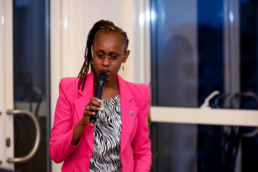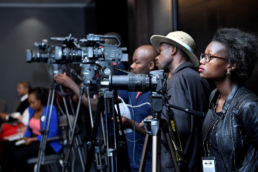The Role of the News Desk in Fact-Checking
In 2022 StopReflectVerify.com launched an evidence-based online quiz aimed at internet users among the 22.1 million registered voters to tackle election-related misinformation and disinformation.
The quiz addresses key vulnerable areas of media literacy using social media insights.
Born out of The Stop Reflect Verify quiz was a three-part podcast series. The Stop Reflect Verify Podcast offers more context, helping you if you’ve ever been shamed into sharing, fooled into forwarding, or tricked by trending topics on social media.
Our third and final episode features Carole Kimutai, the managing editor for Standard Group Digital, one of Kenya’s largest media publishers.
In this episode Mark Kaigwa, Host and Founder of StopReflectVerify, and Carole Kimutai talk about the rigorous process of fact-checking in a newsroom, the role of the media at large, including journalists in fighting fake news and civic education on how to Stop Reflect Verify before sharing news.
“People who are out to share fake news and misinform know what they’re doing”, Carole Kimutai, “Videos are the latest deep fakes to manipulate crowds”. Kimutai talks about how fake news techniques are getting smarter and shares a few tips the news deck utilize to spot misinformation and stop it in its tracks.
Watch our latest episode on Youtube or listen on Spotify.
The Evolution of Politics on Digital Platforms
In 2022 StopReflectVerify.com launched an evidence-based online quiz aimed at internet users among the 22.1 million registered voters to tackle election-related misinformation and disinformation.
The quiz addresses key vulnerable areas of media literacy using social media insights.
Born out of The Stop Reflect Verify quiz was a three-part podcast series. The Stop Reflect Verify Podcast offers more context, helping you if you’ve ever been shamed into sharing, fooled into forwarding, or tricked by trending topics on social media.
Our second episode features Odanga Madung, Co-founder of Odipo Dev, a media and research company popularly known for calling out information pollution tactics, especially in politics.
In this episode Mark Kaigwa, Host and Founder of StopReflectVerify, and Odanga Madung talk about the evolution of politics on digital platforms.
“In 2013 you have (politicians pay) Kes 30,000 per tweet…the political misinformation for hire industry in Kenya..is now experiencing an economics of scale.” Madung
With more demand for always-on content, middlemen became an integral part of disinformation campaign strategies where the cost per tweet has been drastically lowered to “$15-20 per campaign”.
Learn more about the state of information pollution, Twitter’s active contribution to its existence, and how it crops up successfully every 4-5 years.
Watch our latest episode on Youtube or listen on Spotify.
Misinformation And The Art Of Fact Checking
In 2022 StopReflectVerify.com launched an evidence-based online quiz aimed at internet users among the 22.1 million registered voters to tackle election-related misinformation and disinformation.
The quiz addresses key vulnerable areas of media literacy using social media insights.
Born out of The Stop Reflect Verify quiz was a three-part podcast series. The Stop Reflect Verify Podcast offers more context, helping you if you’ve ever been shamed into sharing, fooled into forwarding, or tricked by the trending topics on social media.
Our first episode features Alphonce Shiundu, the Kenya editor at Africa Check, a nonprofit fact-checking organization working all over the continent.
In this episode Mark Kaigwa, Host and Founder of StopReflectVerify, and Alphonce Shiundu talk about the differences between misinformation in the 2017 and 2022 general elections in Kenya.
How To Spot False News
Headlines, images, social media teasers, and other content can be used directly or inadvertently to promote false news, support or legitimize misinformation, and feed conspiracy theories.
So how can you spot news when it’s fake?
Stop, Reflect and Verify.
Practice evaluation skills and develop a critical mindset. Don’t just look at what a web page tells you about itself. Instead, do a web search and find out what others are saying about them. This will help you determine the accuracy of the information.
Here is what to look for:
1. The News Authority
Who is the author and where did the item originate? Check on the individual, company or institution, to see where their biases (personal inclinations/favouritisms) are. Is the author’s name listed? What are the credentials that make them an expert in the topic?
If you are uncertain, verify the information you see on verified or trusted platforms. You can also explore AfricaCheck, PesaCheck, PigaFirimbi, AFPCheck, and StopReflectVerify among other fact-checking platforms that can help debunk false news.
2. Accuracy of the News
Information that is accurate and free from errors is considered more reliable. One or two typos are ok but information that is presented in a sloppy manner with too many spelling or grammatical mistakes comes across as unprofessional. Are there links to other resources to back up the claims one source is making? For statistical references and data check where they come from. Numbers can be easily changed and manipulated to show personal opinions. Fact and opinion are different.
3. Objectivity
Check to see if the information is presented with the least amount of prejudice or personal bias. Is it an opinion or is it trying to sell you something?
4. Timeliness
When was the information first published? Is the content you are looking at up-to-date, or is the website updated regularly, or is it something that is old and made to look like new information?
5. Platforms
You should be suspicious of the content you read, including audio, text and videos. Today, social media platforms like TikTok, YouTube and Instagram are as active or popular in sharing false news as Facebook, Twitter and WhatsApp.
Enjoyed this article? You can also read, 3 False News Techniques
How Media Staff Can Avoid Creating Disinformation
Fake and biased news are two different things. Fake news is without basis or fact. Biased news presents facts, but does so selectively and/or with language that sensationalizes.
Almost all writing has some form of implicit bias, but the best researchers and journalists strive to acknowledge and eliminate both bias and disinformation in their own work.
The following are a few tips on how you can do this too.
- Consider biases related to the tribe, gender, ability, orientation, and other protected classes. Question and debunk stories, lines of questioning, and language that perpetuates bias.
- Women often face the challenges of being stereotyped, objectified, and hypersexualized. Be mindful of avoiding these tropes and debunk them whenever possible.
- When choosing a nominee photo, ensure that it looks professional and doesn’t play into any negative stereotypes.
- Ambition in women is often portrayed as negative and praised in men – avoid playing into this sexist stereotype.
- Use gender-neutral language to help stop gender bias.
- Use businessperson, chairperson, congressperson, etc
- Avoid using Mrs. unless it’s preferred by the nominee, use Ms. because it doesn’t designate marital status. Single women have historically been seen as undesirable or unworthy.
- Use the proper title, such as Honorable, Senator, Secretary
- Reporting on disinformation rather than debunking it can help spread it. You must call out disinformation as unfounded, a conspiracy theory, debunked, dubious, unlikely, misleading, a lie, false, etc. in the headline if you must write about disinformation.
- Avoid covering “trending” topics on Twitter as reflective of broad public support. Twitter “trends” are based on many factors and do not necessarily mean that a large number of users are participating in the conversation.
- Think about your personal biases otherwise known as confirmation bias. This is the tendency to search for, interpret, favour, and recall information in a way that confirms or supports one’s prior beliefs or values.
- Explore AfricaCheck, PesaCheck, PigaFirimbi, AFPCheck, and StopReflectVerify among other fact-checking platforms that are helping to debunk misinformation and disinformation.
- Check out TinEye and Reverse Image Search for images you doubt their authenticity and Amnesty International’s YouTube Dataviewer or download the InVid browser extension for videos.
- Whenever you are suspicious of an article, check the URL and read some more articles on the same website. Some platforms are quite good at sneaking in a few false articles amidst many true or accurate articles, to deepen the believability of the fake ones. Also do check the URL clearly to ensure it’s not cybersquatting, where it mimics a true or genuine website.
3 Fake News Techniques
It’s easy to see why fake news is a problem, but it’s harder to identify and prevent it from spreading. Many social media users, including journalists and politicians, are aware of issues regarding fake news. Yet, they unknowingly give it credence by sharing misleading, incorrect, and downright fabricated “news” on Facebook, Twitter, and other platforms.
In this article, we share three popular fake news techniques we’ve observed during the election period.
1. Fake News Technique One – Quote Pics
Many people repost articles on social media after reading the headline, but without reading the whole text. Putting a misleading title on real news is one of the most common fake news techniques.
Taking quotations out of context is another common trick. An example is a quote attributed to the National Rainbow Coalition-Kenya (NARC-Kenya) party leader, Martha Karua, commenting about the Amani National Congress (ANC) party and United Democratic Alliance (UDA) party union.
Karua hails the new ANC and UDA partnership in the quote and urges Kenyans to reject ‘political projects’, which is inaccurate.
“The union of ANC and UDA has started a new chapter of Killing all political conmanship and politics of deceit In Kenya. Together we can reject political projects! ~~Iron lady Martha Karua,” the quote reads.
However, through her verified Twitter account, Karua has termed the quote fake.
2. Technique Two – Party Defections
In Kenya’s 2017 election campaign, the issue of fake news shot into the limelight in April when a doctored front page of the Daily Nation circulated in Busia County during the primaries. It claimed that the opposition Orange Democratic Movement’s Dr. Paul Otuoma had defected to the ruling Jubilee party. The story was designed to discredit him on the day of the nomination.
Deliberately false or inaccurate news is commonplace during elections, especially stories about supposed defections. An analysis of the content suggests that much of it is part of political actors’ orchestrated and strategic campaigns.
In our very own SRV quiz, we address two stories about Dr. Eric Mutai and Dr. Boni Khalwale.
A screenshot of what appears to be a post by Emoo FM, a radio station in Kenya broadcasting in the Kalenjin dialect, was shared on Facebook. The 11th February 2022 post claiming Eric Mutai had left the United Democratic Alliance (UDA) “to be Independent was fake.
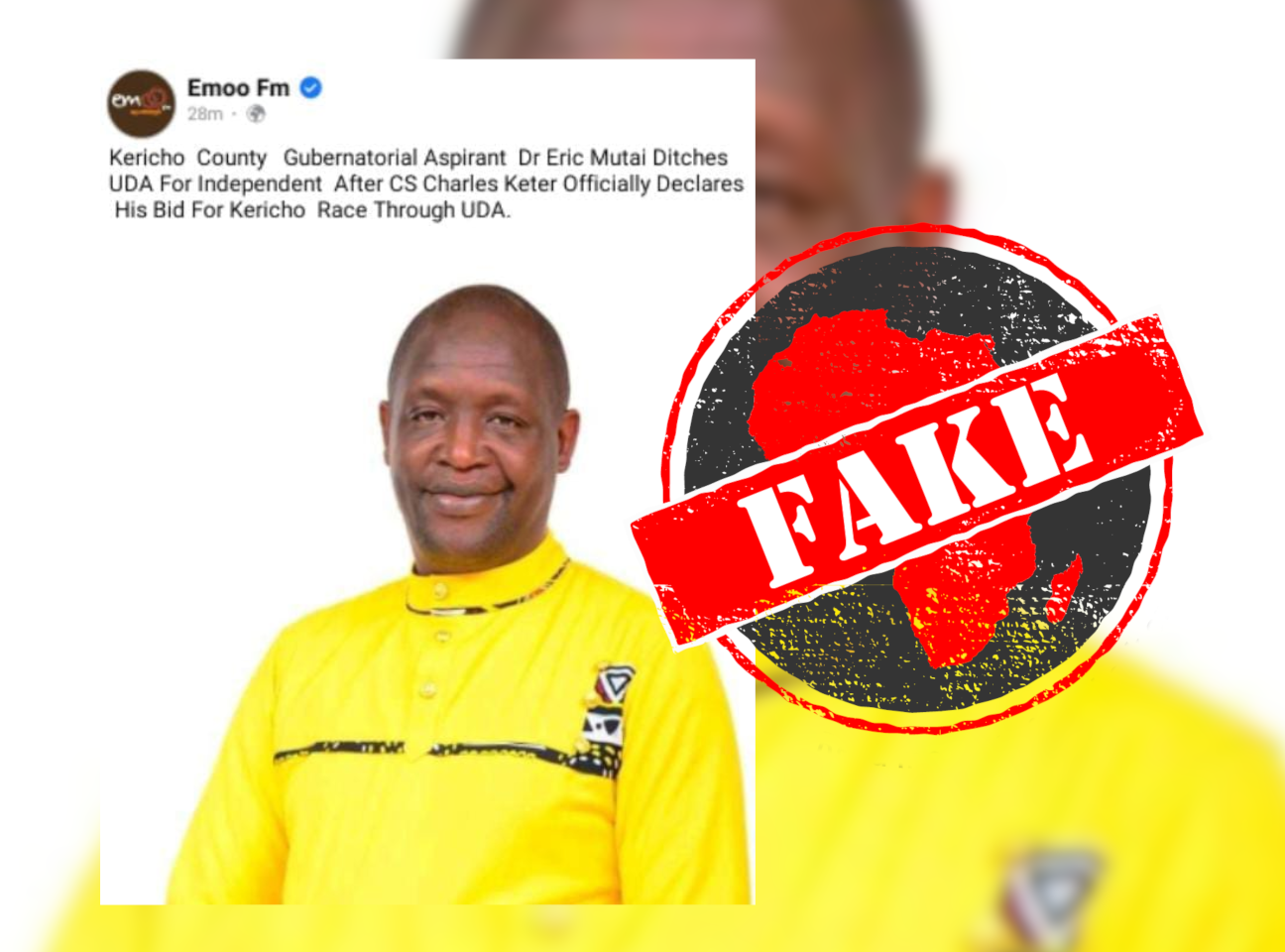
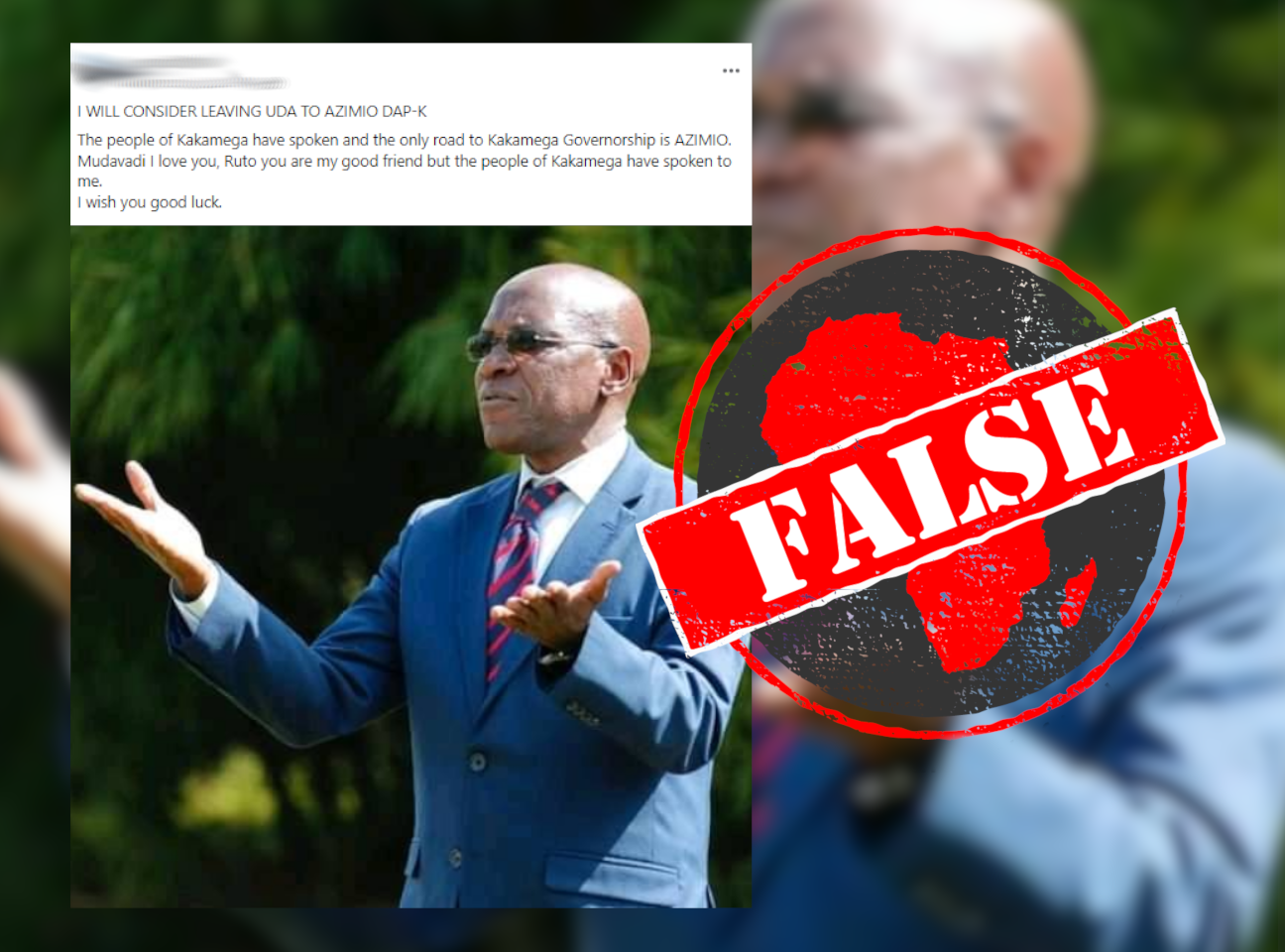
Furthermore, a message posted on Facebook in late January 2022 quotes Kenyan politician Boni Khalwale, a former Senator for Kakamega county and member of the United Democratic Alliance (UDA), as saying he may leave his party to join the Azimio la Umoja coalition of political parties.
According to Africa Check, this account is false.
3. Technique Three – Photo Manipulation
Photo manipulation is the easiest way to fake news, but also the simplest to expose. There are two common techniques of photo manipulation.
The first is editing photos in special programs, such as Adobe Photoshop. The second is presenting real photos as having been taken at another time or place.
One example featured on the SRV quiz is a photo circulating on Facebook that shows Kenyan opposition leader Raila Odinga and his son Raila Odinga Junior.
The son, wearing a yellow shirt and navy blue bomber jacket, is standing next to his father whose eyes are focused on a newspaper on a table. Two words on the son’s shirt, printed in black ending in “rm” and “DA”, are partially hidden by his jacket.
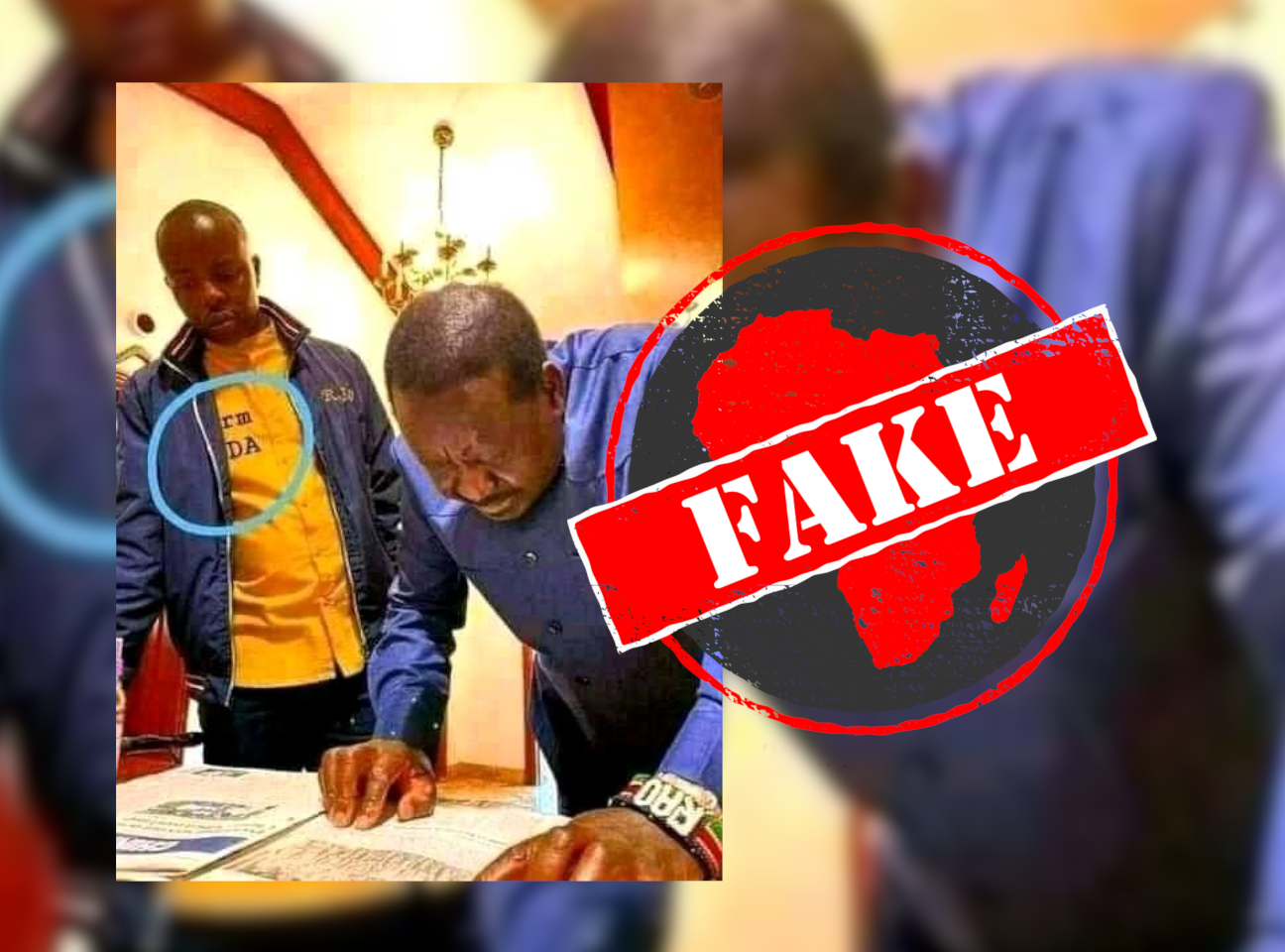
The colours and slogan are associated with the United Democratic Alliance (UDA), a party marketed by deputy president William Ruto in his political campaigns, Raila’s rival.
Users who posted the photo filled in the missing words based on the hashtag used by the UDA’s #FormNiUDA, which translates from Sheng urban slang as “The trend is UDA”.
“Kube Raila’s Son ni wa UDA…?! Or what do those words in his shirt reads.. #FormNiUDA or what!!” exclaimed one user. The Kiswahili roughly translates as: “You mean Raila’s son belongs to the UDA party?
Enjoyed this article? You can also read, The Rise of Fake News In Kenya,
StopReflectVerify Launches Kenyan Election Misinformation Quiz
With 2022 being an election year, StopReflectVerify.com has launched an evidence-based online quiz aimed at internet users among the 22.1 million registered voters.
The quiz addresses key vulnerable areas of media literacy using social media insights. StopReflectVerify.com quiz aims to prompt behaviour change among Kenya’s 23.25 million internet users.
StopReflectVerify.com, a website that hosts an internet-based quiz focused on misinformation, has launched a new quiz focused on the Kenyan general election. The elections are reaching a fever pitch with Kenyans set to elect 1,450 members of the county assembly (MCAs), 290 members of the national assembly (MPs), 47 county woman representatives to the national assembly, 47 county senators, 47 county governors, and one president and deputy president. The media ecosystem of broadcast media and digital media presents various challenges that leave room for misinformation.
Kenyans have to contend with various kinds of misinformation. In some cases, there’s no intent to harm; content is presented out of context. In other cases, it is deliberately published for harm.
Chris Machin, Cultural Affairs Officer at the U.S. Embassy in Nairobi, said at the launch, “Here in Kenya, the United States has contributed nearly $20m to strengthen Kenyan-led efforts to enhance accountability and transparency of the election process.” He continued, “As internet penetration continues to rise, the threat of misinformation persists online and offline. StopReflectVerify.com aims to engage them with a test on misinformation regarding the elections. People can test their knowledge and have an interactive learning experience.”
Mark Kaigwa, Founder and Team Leader of StopReflectVerify.com, said at the launch, “Messaging apps such as WhatsApp, Facebook, Twitter, and TikTok play a growing role in the spread of news and information. The information disorder varies from platform to platform, and it will take vigilance on voters and greater work by platforms ahead of August 9th. A section of Kenyan internet users is being exposed to mis, dis, and mal-information. StopReflectVerify.com aims to counteract this by reaching those who may be fooled into forwarding, shamed into sharing or tricked by the trends. StopReflectVerify.com aims to solicit Kenyans and engage their friends, families, and peers to stop, reflect, and verify before sharing.”
The StopReflectVerify.com quiz was built through research and evidence collected from surveying +100,000 social media updates across the web in 2022. In addition, support in the form of data and insights from fact-checking initiatives AfricaCheck.org and PesaCheck.org contributed to a deeper understanding of what fact-checkers are doing in response. This evidence-based approach is what turns the quiz from an online game to a critical resource in battling the spread of misinformation on the internet and social media platforms.
Can you spot fake news related to the election? Take the Election Misinformation Quiz
The Rise of Fake News In Kenya
The impact of fake news in Kenya started earlier but culminated in 2007, when a disputed election led to Kenya’s worst post-election violence, in which the media was criticized for generating and sharing inciteful content, self-censorship, and biased reporting.
It was so bad that Journalist, Joshua Sang’, was one of six people charged with crimes against humanity by the International Criminal Court (ICC).
The media is no longer regarded as an entirely reliable source.
According to the most current quantitative data from a GeoPoll study conducted for Internews as part of this research, 60% of Kenyans “don’t entirely” trust the media. Furthermore, partisanship in the media, as represented in ownership, management, and editorial decisions, has been highlighted as a major barrier to confidence in the media.

The rise of false news, which largely lives online, has contributed to some of this mistrust. As a result, Kenya had a highly contentious electioneering season between August and October of 2017.
Kenya suffers from severe tribal polarization, a consequence of the British colonial policy of “divide and rule” that has been continued post-independence by African-led governments. This typically peaks around pre-election and election seasons.
Fake news and hate speech in the media surged dramatically in 2017, and this tendency has since continued.
In fact, the biggest challenge encountered by Safaricom, the largest mobile service provider with over 26 million members, in 2017 was the sheer volume of fake news passing through their networks.
The problem is so widespread that many organizations including StopReflectVerify have been formed solely to combat false news.
The Digital Media Landscape In Kenya
Digital Media in Kenya has caught up with television, one of the country’s most accessible traditional media channels. In a 2021 GeoPoll survey sampling 1,905 respondents, 8 out of every 10 persons had access to both sorts of media within the last 30 days.
There are 23.35 million internet users in Kenya’s overall population of 55.60 million people! At the beginning of 2022, Kenya’s internet penetration rate was 42% of the entire population.
Digital media usage is likely to continue “changing swiftly” due to increased technological innovation, the availability of more cheap smartphones on the market, and improved connections (3G, 4G, and 5G) in the nation.
Furthermore, in January 2022, Kenya had 11.75 million social media users. According to Kepios data, social media users in Kenya rose by 750,000 (+6.8%) between 2021 and 2022.
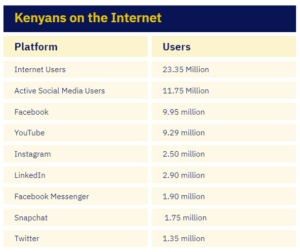
Kenya has a vibrant social media environment that reflects both the vast range of information viewers seek and the culture of online content consumption. Kenya alone has hundreds of blogs. According to the Bloggers Association of Kenya [BAKE], a membership organization, there are 19,000 blogs in Kenya.
From money to gastronomy, there are blogs for practically anything. Political blogging, on the other hand, reigns dominant. Interactions on social media are also highly political, with tribal or ethnic overtones on Facebook and WhatsApp. And it is on social media that fake news thrives!
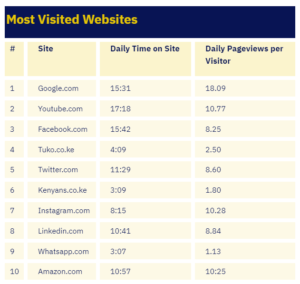
The Traditional Media Landscape in Kenya
Kenya’s media landscape presently comprises a wide variety of print, television, and online platforms. The private sector is largely responsible for the generation and distribution of information, although it is closely supervised by the government.
According to a nationally representative survey done in 2015 by BBC Media Action, almost all of Kenya’s adult population (98%) has access to radio and a mobile phone (97%). Connection to television is also common (81%), and internet connection is available to more than half of the adult population (51%).
Six years later, radio remained the most popular form of media, according to a GeoPoll National Media Establishment Survey of 1,905 respondents, with nearly nine out of every ten respondents in the research having listened to the radio in the preceding 30 days.

The internet has eclipsed television in popularity. Eight out of every ten people have had access to both types of media in the past 30 days. Furthermore, little over half of the studied respondents are print readers.
Access To Media By Gender
For several media, the prevalence of consumption varies by gender. Males had more access to the radio (+6%) than females. This gap was observed again in newspaper readership, with males finding to be +9% greater than females.
Access To Media By Age
While radio listenership was high (over 80%) across all age groups, there was a greater age bias as respondents became older. Individuals aged 25-34 and 35+ were also more likely to watch television than those aged 15-24.
People aged 25 to 34 are more likely to read print media such as newspapers and magazines. As expected, younger age groups (15-24 year-olds and 25-34-year-olds) use the internet more often than those aged 35 and older.
Radio Media In Kenya
According to the Media Council of Kenya’s (MCK) 2021 Status of Media Report, radio was the major source of information in Kenya and the most popular media channel (74%). There are almost 200 licensed radio stations in the nation, all of which are functioning.
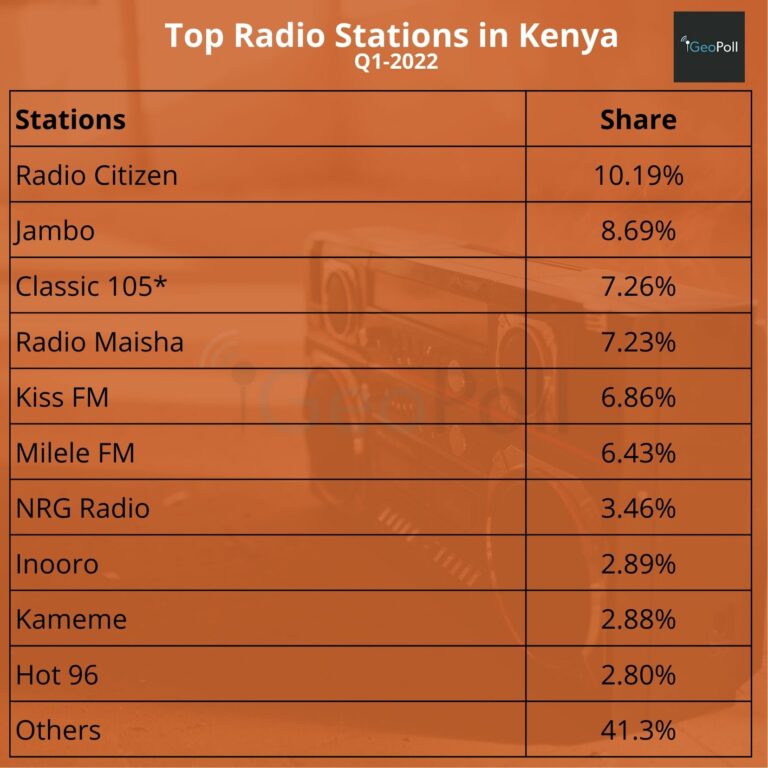
Despite a significant concentration of radio stations in urban areas, over 60 private vernacular radio stations broadcasting in many languages have a strong presence in rural Kenya. Among them are nearly 40 community radio stations.
Unfortunately, many of these radio stations are ill-equipped and understaffed, and the majority are owned by or affiliated with politics. Mediamax, which owns Kameme FM and Milele FM, for example, has links to President Uhuru Kenyatta’s family.
The Standard Group, which owns Radio Maisha, Vybes Radio, and Spice FM, has links to the Moi family, while Royal Media Services, which owns 14 radio stations including Radio Citizen, is controlled by Raila Odinga’s close colleague Samuel Kamau Macharia. Joshua Chepkwony, the owner of Kass FM, is alleged to have close relations with Deputy President William Ruto. This raises the crucial question of objective reporting.
Television Media In Kenya
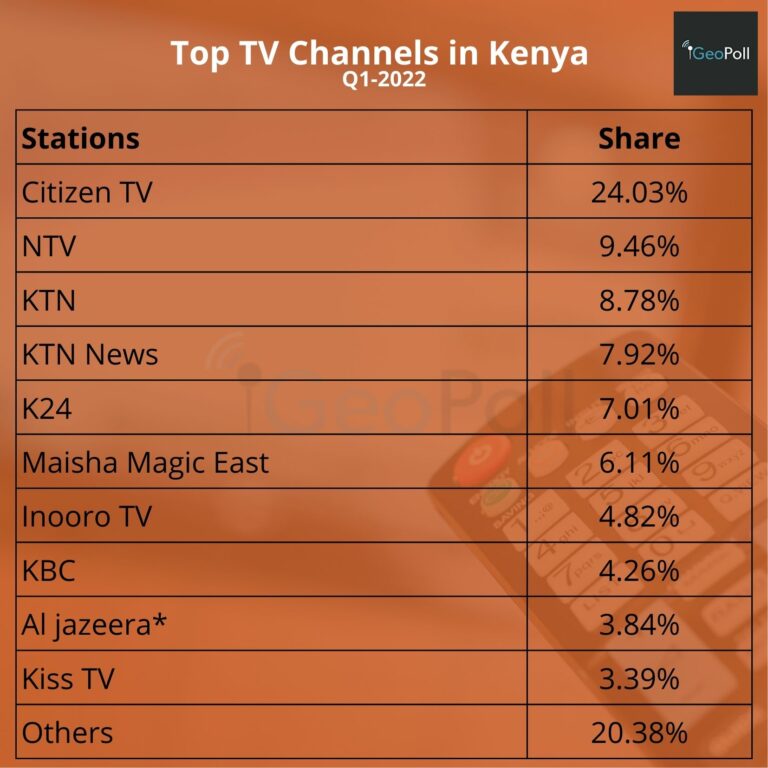
In recent years, a television in Kenya has seen both highs and lows. Its most recent low came in February 2018, when the government shut down Citizen TV, Nation TV, and KTN TV for more than a week for airing Raila Odinga’s swearing-in as ‘the Peoples’ President,’ despite warnings from the government. Despite being called to State House and warned not to broadcast it, its senior executives and editors saw it as a question of journalistic independence and broadcast it anyway.
Its peak might potentially be during the COVID-19 period, when, according to the Media Council of Kenya’s (MCK) 2020 Status of Media Report, it reached 74% of Kenyans, similar to radio. This was due to the government’s mobility limitations, which forced individuals to stay at home.
However, according to the 2021 report, which was issued in January 2022, TV popularity was 58%, indicating a reduced audience reach when COVID-19 limitations were abolished and people returned to normal.
TV is embroiled in the same ownership dynamics as radio. The First Family, which is reported to control Mediamax, owns K24, Royal Media Services owns Citizen TV, and the Standard Group owns KTN and KTN News. Aga Khan is the owner of NTV. The Nairobi Securities Exchange (NSE) lists both Nation and Standard, but the true owners are hidden under nominee corporations and identities.
Citizen TV continues to dominate the Kenyan airwaves, according to data from the Quarter 1, 2022 Geopoll measuring survey, with a 24% total share. NTV (9.5%) came in second, followed by The Standard Group’s sister networks KTN and KTN News, and K24. Inooro TV (4.8%) and Al Jazeera (3.84%) were the only vernacular and foreign networks in the top 10 by the audience, respectively.


